
This is a list of globular clusters. The apparent magnitude does not include an extinction correction.

This is a list of globular clusters. The apparent magnitude does not include an extinction correction.
These are globular clusters within the halo of the Milky Way galaxy. The diameter is in minutes of arc as seen from Earth. For reference, the J2000 epoch celestial coordinates of the Galactic Center are right ascension 17h 45m 40.04s, declination −29° 00′ 28.1″. A high proportion of globular clusters are located in the Ophiuchus and Sagittarius constellations, both of which lie in the direction of the galactic core.
| Identifier | Image | Epoch J2000 | Constellation | Apparent Magnitude | Diameter (′) | Distance (ly) | Notes and references | |
|---|---|---|---|---|---|---|---|---|
| Right ascension | Declination | |||||||
| FSR 584 | 02h 27m 15s | +61° 37′ 28″ | Cassiopeia | N/A | 6 | 4,570 | Possibly an open cluster [4] | |
| M4 (Spider Globular Cluster) |  | 16h 23m 35.36s | −26° 31′ 32.7″ | Scorpius | 5.63 | 36 | 6,033 | |
| NGC 6397 | 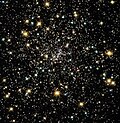 | 17h 40m 42.04s | −53° 40′ 26.3″ | Ara | 5.73 | 31 | 7,800 | |
| NGC 6544 |  | 18h 07m 20.58s | −24° 59′ 50.7″ | Sagittarius | 7.77 | 9.1 | 9,450 | |
| M22 (Great Sagittarius Cluster) |  | 18h 36m 23.97s | −23° 54′ 14.5″ | Sagittarius | 5.10 | 32 | 10,600 ± 1.0 | |
| NGC 6366 | 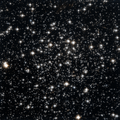 | 17h 27m 44.24s | −05° 04′ 47.5″ | Ophiuchus | 9.20 | 13 | 11,700 | |
| NGC 6540 |  | 18h 06m 08.60s | −27° 45′ 55.0″ | Sagittarius | 9.30 | 1.5 | 12,070 ± 0.98 | |
| NGC 6752 |  | 19h 10m 52.11s | −59° 59′ 02.2″ | Pavo | 5.40 | 29 | 13,000 | |
| M71 (Angelfish Cluster) |  | 19h 53m 46.49s | +18° 46′ 45.1″ | Sagitta | 8.19 | 7.2 | 13,000 | |
| Mercer 3 (GLIMPSE-C02) |  | 18h 18m 30.50s | −16° 58′ 38.0″ | Sagittarius | unknown | unknown | 13,000–26,000 | |
| M10 |  | 16h 57m 09.03s | −04° 06′ 00.6″ | Ophiuchus | 6.60 | 20 | 14,300 | |
| 47 Tucanae |  | 00h 24m 05.67s | −72° 04′ 52.6″ | Tucana | 4.09 | 50 | 14,500 ± 32.6 | |
| NGC 3201 | 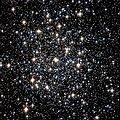 | 10h 17m 36.82s | −46° 24′ 44.9″ | Vela | 6.75 | 20 | 14,800 | |
| Omega Centauri |  | 13h 26m 47.24s | −47° 28′ 46.5″ | Centaurus | 3.9 | 55 | 15,800 ± 1.1 | Visually brightest globular cluster, most massive and largest globular cluster in Milky Way |
| NGC 5466 | 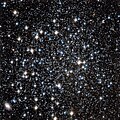 | 14h 05m 27.29s | +28° 32′ 04.0″ | Boötes | 9.04 | 9 | 16,000 ± 0.4 | |
| 2MASS-GC02 (Hurt 2) |  | 18h 09m 36.50s | −20° 46′ 44″ | Sagittarius | 24.60 | 1.9 | 16,000 | |
| M12 |  | 16h 47m 14.18s | −01° 56′ 54.7″ | Ophiuchus | 6.70 | 16 | 16,440 ± 0.16 | |
| M55 (Specter Cluster) |  | 19h 39m 59.71s | −30° 57′ 53.1″ | Sagittarius | 6.32 | 19 | 17,600 | |
| M28 | 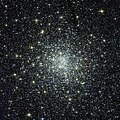 | 18h 24m 32.81s | −24° 52′ 11.2″ | Sagittarius | 6.79 | 11.2 | 18,260 ± 0.98 | |
| NGC 6352 |  | 17h 25m 29.11s | −48° 25′ 19.8″ | Ara | 7.96 | 9 | 18,300 | |
| Terzan 5 | | 17h 48m 04.80s | −24° 46′ 45.0″ | Sagittarius | 13.85 | 2.4 | 18,800 ± 1.6 | |
| NGC 4372 | 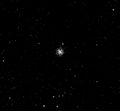 | 12h 25m 45.40s | −72° 39′ 32.7″ | Musca | 7.24 | 5 | 18,900 | |
| NGC 6304 |  | 17h 14m 32.25s | −29° 27′ 43.7″ | Ophiuchus | 8.22 | 8 | 19,200 | |
| Palomar 10 | 19h 18m 02.10s | +18° 34′ 18.0″ | Sagitta | 13.22 | 4.0 | 19,200 | ||
| NGC 6553 | 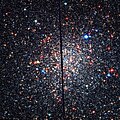 | 18h 09m 17.60s | −25° 54′ 31.3″ | Sagittarius | 8.06 | 9.1 | 19,600 | |
| Terzan 1 |  | 17h 35m 47.80s | −30° 28′ 11.0″ | Scorpius | 15.9 | 2.4 | 20,000 | |
| M107 (Crucifix Cluster) |  | 16h 32m 31.86s | −13° 03′ 13.3″ | Ophiuchus | 7.93 | 13 | 20,900 | |
| M62 (Flickering Globular Cluster) |  | 17h 01m 12.80s | −30° 06′ 49.4″ | Ophiuchus | 6.45 | 15 | 21,500 ± 1.3 | |
| NGC 4833 |  | 12h 59m 34.46s | −70° 52′ 32.2″ | Musca | 6.91 | 14 | 21,500 | |
| NGC 6256 | | 16h 59m 32.62s | −37° 07′ 17.0″ | Scorpius | 11.29 | 4.1 | 22,000 | |
| VVV CL160 | 18h 06m 57.0s | −20° 00′ 40″ | Sagittarius | 6 | 22,170 | [5] | ||
| M13 (Great Hercules Cluster) |  | 16h 41m 41.37s | +36° 27′ 36.2″ | Hercules | 5.78 | 20 | 22,200 | |
| NGC 6535 |  | 18h 03m 50.51s | −00° 17′ 51.5″ | Serpens | 10.47 | 3.4 | 22,200 | |
| FSR 9 | 18h 28m 30.6s | −31° 54′ 24″ | Sagittarius | 7.2 | 22,500 | [5] | ||
| FSR 25 | 17h 41m 43.2s | −19° 34′ 16″ | Ophiuchus | N/A | unknown | 22,830 | [6] | |
| FSR 19 | 17h 35m 38.4s | −21° 04′ 12″ | Ophiuchus | N/A | unknown | 23,480 | [6] | |
| FSR 1776 (Minniti 23) | 17h 54m 14.40s | −36° 09′ 08.64″ | Scorpius | 23,610 | [7] | |||
| NGC 6717 |  | 18h 55m 06.04s | −22° 42′ 04.1″ | Sagittarius | 9.28 | 5.2 | 23,800 ± 1.6 | |
| NGC 5897 |  | 15h 17m 24.50s | −21° 00′ 37.0″ | Libra | 8.53 | 11 | 24,100 | |
| NGC 6558 |  | 18h 10m 17.80s | −31° 45′ 50.0″ | Sagittarius | 9.26 | 4.1 | 24,100 | |
| NGC 6760 |  | 19h 11m 12.01s | +01° 01′ 49.8″ | Aquila | 8.88 | 9.6 | 24,100 | |
| FSR 1716 (VVV CL005) | 16h 10m 30.0s | −53° 44′ 56″ | Norma | N/A | 3 | 24,460 | [8] | |
| M5 |  | 15h 18m 33.51s | +02° 04′ 54.9″ | Serpens | 5.65 | 21.6 | 24,500 | |
| NGC 6362 |  | 17h 31m 54.99s | −67° 02′ 54.0″ | Ara | 7.73 | 15 | 24,800 | |
| NGC 6541 |  | 18h 08m 02.28s | −43° 42′ 53.6″ | Corona Australis | 6.30 | 15 | 24,800 ± 0.3 | |
| Palomar 6 |  | 17h 43m 42.20s | −26° 13′ 21.0″ | Ophiuchus | 11.55 | 1.2 | 25,020 ± 0.62 | |
| NGC 5927 |  | 15h 28m 00.69s | −50° 40′ 22.5″ | Lupus | 8.01 | 6 | 25,100 | |
| NGC 6401 | | 17h 38m 36.60s | −23° 54′ 34.2″ | Ophiuchus | 9.45 | 4.9 | 25,100 | |
| NGC 6522 |  | 18h 03m 34.02s | −30° 02′ 02.1″ | Sagittarius | 8.27 | 9.2 | 25,100 | |
| NGC 6325 | | 17h 17m 59.21s | −23° 45′ 57.6″ | Ophiuchus | 10.33 | 4.1 | 25,400 | |
| M9 |  | 17h 19m 11.53s | −18° 30′ 58.2″ | Ophiuchus | 7.72 | 12 | 25,800 | |
| NGC 6528 |  | 18h 04m 49.64s | −30° 03′ 21.8″ | Sagittarius | 9.60 | 5 | 25,800 | |
| NGC 6624 |  | 18h 23m 40.51s | −30° 21′ 39.9″ | Sagittarius | 7.87 | 8.8 | 25,800 ± 1.1 | |
| NGC 6712 | 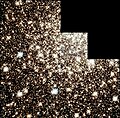 | 18h 53m 04.30s | −08° 42′ 22.0″ | Scutum | 8.10 | 9.8 | 26,400 | |
| Liller 1 | | 17h 33m 24.50s | −33° 23′ 20.4″ | Scorpius | 16.77 | 6.8 | 26,400 ± 3.3 | |
| NGC 6539 |  | 18h 04m 49.68s | −07° 35′ 09.0″ | Serpens | 9.33 | 7.9 | 26,630 | |
| M92 |  | 17h 17m 07.35s | +43° 08′ 09.4″ | Hercules | 6.44 | 14 | 26,700 | |
| NGC 6642 |  | 18h 31m 54.10s | −23° 28′ 32.8″ | Sagittarius | 9.13 | 5.8 | 26,700 ± 2.3 | |
| VVV CL001 | | 17h 54m 42.5s | −24° 00′ 53″ | Sagittarius | N/A | N/A | 26,800 | [2] |
| NGC 6440 | | 17h 48m 52.70s | −20° 21′ 36.9″ | Sagittarius | 9.2 | 4.4 | 27,100 ± 1.3 | |
| M30 (Jellyfish Cluster) |  | 21h 40m 22.12s | −23° 10′ 47.5″ | Capricornus | 7.19 | 12 | 27,140 ± 0.65 | |
| NGC 6355 |  | 17h 23m 58.60s | −26° 21′ 12.3″ | Ophiuchus | 9.14 | 4.2 | 27,850 ± 0.62 | |
| NGC 6342 | | 17h 21m 10.08s | −19° 35′ 14.4″ | Ophiuchus | 9.66 | 4.2 | 28,000 | |
| NGC 6723 |  | 18h 59m 33.15s | −36° 37′ 56.1″ | Sagittarius | 7.01 | 13 | 28,400 | |
| M19 |  | 17h 02m 37.80s | −26° 16′ 04.7″ | Ophiuchus | 6.77 | 17 | 28,700 | |
| M69 |  | 18h 31m 23.10s | −32° 20′ 53.1″ | Sagittarius | 7.64 | 8.45 | 29,000 | |
| NGC 362 |  | 01h 03m 14.26s | −70° 50′ 55.6″ | Tucana | 6.40 | 14 | 29,290 ± 0.20 | |
| NGC 288 |  | 00h 52m 46.37s | −26° 34′ 58.7″ | Sculptor | 8.09 | 13 | 29,220 ± 0.16 | |
| FSR 1775 | 17h 56m 05.3s | −36° 33′ 57″ | Scorpius | 6 | 29,030 | [5] | ||
| M70 |  | 18h 43m 12.76s | −32° 17′ 31.6″ | Sagittarius | 7.87 | 8 | 29,400 | |
| NGC 6139 | | 16h 27m 40.37s | −38° 50′ 55.7″ | Scorpius | 8.99 | 8.1 | 30,000 | |
| M14 |  | 17h 37m 36.10s | −03° 14′ 45.3″ | Ophiuchus | 7.59 | 11 | 30,300 | |
| NGC 6287 |  | 17h 05m 09.13s | −22° 42′ 29.6″ | Ophiuchus | 9.35 | 4.9 | 30,300 | |
| NGC 6293 | | 17h 10m 10.20s | −26° 34′ 55.5″ | Ophiuchus | 8.22 | 8.1 | 31,000 | |
| NGC 2808 |  | 09h 12m 03.05s | −64° 51′ 48.6″ | Carina | 6.20 | 14 | 31,300 | |
| NGC 6638 | 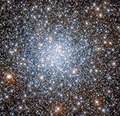 | 18h 30m 56.10s | −25° 29′ 50.9″ | Sagittarius | 9.02 | 7.15 | 31,300 ± 1.6 | |
| M80 |  | 16h 17m 02.41s | −22° 58′ 33.9″ | Scorpius | 7.33 | 10 | 32,600 | |
| FSR 190 | 20h 05m 31.3s | +33° 34′ 09″ | Cygnus | N/A | 20.4 | 32,615 | Candidate, [9] possibly an open cluster [10] [11] | |
| M56 |  | 19h 16m 35.57s | +30° 11′ 00.5″ | Lyra | 8.27 | 8.8 | 32,900 | |
| FSR 1700 | 15h 38m 52.5s | −59° 16′ 03″ | Norma | N/A | N/A | 33,590 | Candidate [12] | |
| M68 |  | 12h 39m 27.99s | −26° 44′ 38.6″ | Hydra | 7.84 | 11 | 33,600 | |
| M3 |  | 13h 42m 11.62s | +28° 22′ 38.2″ | Canes Venatici | 6.19 | 18 | 33,900 | |
| NGC 5986 |  | 15h 46m 03.25s | −37° 47′ 10.6″ | Lupus | 7.52 | 9.7 | 33,900 | |
| FSR 1767 | 17h 35m 43.0s | −36° 21′ 28″ | Scorpius | 6 | 34,570 | [5] | ||
| NGC 2298 | 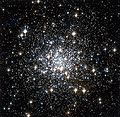 | 06h 48m 59.41s | −36° 00′ 19.1″ | Puppis | 9.29 | 5 | 34,900 | |
| NGC 6380 |  | 17h 34m 28.00s | −39° 04′ 09.0″ | Scorpius | 11.31 | 3.6 | 35,500 | |
| NGC 6569 | 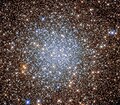 | 18h 13m 38.80s | −31° 49′ 36.8″ | Sagittarius | 8.55 | 6.2 | 35,500 | |
| NGC 6388 |  | 17h 36m 17.23s | −44° 44′ 06.9″ | Scorpius | 6.72 | 10.2 | 35,600 ± 1.5 | |
| M15 |  | 21h 29m 58.33s | +12° 10′ 01.1″ | Pegasus | 6.20 | 18 | 35,690 ± 0.43 | |
| NGC 5286 |  | 13h 46m 26.81s | −51° 22′ 25.7″ | Centaurus | 7.34 | 11 | 35,900 | |
| Palomar 1 |  | 03h 33m 20.04s | +79° 34′ 51.8″ | Cepheus | 13.18 | 2.8 | 36,500 ± 4.2 | |
| NGC 6316 |  | 17h 16m 37.30s | −28° 08′ 24.2″ | Ophiuchus | 8.43 | 5.2 | 36,860 ± 0.98 | |
| NGC 6496 | 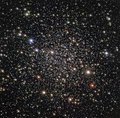 | 17h 59m 02.84s | −44° 15′ 57.4″ | Scorpius | 8.54 | 5.8 | 36,900 | |
| NGC 6453 | | 17h 50m 51.70s | −34° 35′ 57.0″ | Scorpius | 10.08 | 7.6 | 37,800 | |
| FSR 1758 |  | 17h 31m 12s | −39° 48′ 30″ | Scorpius | <7 | 90 | 38,000 | |
| NGC 1851 |  | 05h 14m 06.53s | −40° 02′ 48.8″ | Columba | 7.14 | 12 | 39,500 | |
| M79 |  | 05h 24m 11.09s | −24° 31′ 28.0″ | Lepus | 7.73 | 9.6 | 42,000 | |
| Palomar 8 | 18h 41m 29.90s | −19° 49′ 33.0″ | Sagittarius | 11.02 | 5.2 | 42,100 | ||
| Palomar 11 | 19h 45m 14.40s | −08° 00′ 26.0″ | Aquila | 9.80 | 10.0 | 42,400 | ||
| NGC 6441 |  | 17h 50m 13.03s | −37° 03′ 04.6″ | Scorpius | 7.15 | 9.6 | 42,700 ± 2.3 | |
| NGC 6284 |  | 17h 04m 28.65s | −24° 45′ 53.5″ | Ophiuchus | 8.83 | 6.1 | 43,000 | |
| Djorgovski 1 | | 17h 47m 28.30s | −33° 03′ 56.0″ | Scorpius | 13.6 | 2 | 44,700 | |
| NGC 6584 |  | 18h 18m 37.60s | −52° 12′ 56.8″ | Telescopium | 8.27 | 6.8 | 45,000 | |
| NGC 6101 |  | 16h 25m 48.12s | −72° 12′ 06.9″ | Apus | 9.16 | 5 | 47,600 | |
| NGC 6356 | | 17h 23m 34.96s | −17° 48′ 47.0″ | Ophiuchus | 8.25 | 10 | 49,600 | |
| IC 4499 |  | 15h 00m 18.57s | −82° 12′ 49.6″ | Apus | 9.76 | 7.6 | 50,000 | |
| NGC 6934 |  | 20h 34m 11.49s | +07° 24′ 15.5″ | Delphinus | 8.83 | 7.05 | 52,000 | |
| NGC 1261 |  | 03h 12m 16.21s | −55° 12′ 59.2″ | Horologium | 8.29 | 6.85 | 53,500 | |
| M72 | 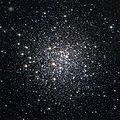 | 20h 53m 27.80s | −12° 32′ 13.7″ | Aquarius | 9.27 | 6.6 | 54,570 ± 1.17 | |
| M2 |  | 21h 33m 28.01s | −00° 49′ 23.4″ | Aquarius | 6.47 | 16 | 55,000 | |
| Segue 3 | 21h 21m 31s | +19° 07′ 02″ | Pegasus | 14.9 | 1.3 | 55,100 ± 2.3 | ||
| NGC 5053 |  | 13h 16m 27.09s | +17° 42′ 00.5″ | Coma Berenices | 9.47 | 10 | 57,000 | |
| M53 | 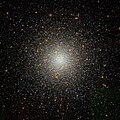 | 13h 12m 55.07s | +18° 10′ 05.4″ | Coma Berenices | 7.61 | 13 | 58,000 | |
| NGC 4147 |  | 12h 10m 06.30s | +18° 32′ 33.5″ | Coma Berenices | 10.32 | 4.4 | 60,000 | |
| NGC 6426 |  | 17h 44m 54.65s | +03° 10′ 12.5″ | Ophiuchus | 11.01 | 4.2 | 67,000 | |
| M75 |  | 20h 06m 04.75s | −21° 55′ 16.2″ | Sagittarius | 8.52 | 6.8 | 67,500 | |
| ESO 280-SC06 | | 18h 09m 06.0s | −46° 25′ 23″ | Ara | 12.00 | 1.5 | 69,800 | |
| Terzan 7 |  | 19h 17m 43.70s | −34° 39′ 27.0″ | Sagittarius | 12 | 6 | 75,700 | [13] |
| Palomar 5 | 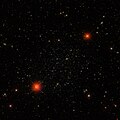 | 15h 16m 05.25s | +00° 06′ 41.8″ | Serpens | 11.75 | 8.0 | 76,000 | |
| NGC 7492 |  | 23h 08m 26.63s | −15° 36′ 41.4″ | Aquarius | 11.29 | 4.2 | 80,000 | |
| IC 1257 | 17h 27m 08.5s | −07° 05′ 35″ | Ophiuchus | 13.10 | 5.0 | 81,500 | ||
| NGC 5634 |  | 14h 29m 37.23s | −05° 58′ 35.1″ | Virgo | 9.47 | 5.5 | 81,900 ± 3.8 | |
| Palomar 13 | 23h 06m 44.44s | +12° 46′ 19.2″ | Pegasus | 13.47 | 0.7 | 84,100 | ||
| Palomar 2 | 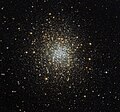 | 04h 46m 05.91s | +31° 22′ 53.4″ | Auriga | 13.04 | 2.2 | 90,000 | |
| NGC 6229 |  | 16h 46m 58.84s | +47° 31′ 39.9″ | Hercules | 9.39 | 4.5 | 100,000 | |
| Balbinot 1 | 22h 10m 42.82s | +14° 56′ 49.0″ | Pegasus | 16.31 | 7.85 | 104,000 | [14] | |
| NGC 5824 |  | 15h 03m 58.63s | −33° 04′ 04.8″ | Lupus | 9.09 | 7.2 | 104,400 | |
| Koposov 2 |  | 07h 58m 17.00s | +26° 15′ 18.0″ | Gemini | 17.6 | unknown | 113,100 | |
| NGC 5694 |  | 14h 39m 36.29s | −26° 32′ 20.2″ | Hydra | 10.17 | 4.3 | 114,100 | |
| Willman 1 |  | 10h 49m 24.00s | +51° 03′ 00.0″ | Ursa Major | 15.3 | 1.75 | 124,000 ± 23 | |
| Pyxis globular cluster | 09h 07m 57.80s | −37° 13′ 17.0″ | Pyxis | 12.9 | 4.0 | 130,000 | ||
| NGC 7006 | 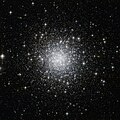 | 21h 01m 29.38s | +16° 11′ 14.1″ | Delphinus | 10.56 | 3.6 | 135,000 | |
| Palomar 15 | 16h 59m 51.00s | −00° 32′ 20.0″ | Ophiuchus | 14.00 | 3.0 | 145,500 | ||
| Koposov 1 |  | 11h 59m 18.50s | +12° 15′ 36.0″ | Virgo | 14.2 | unknown | 157,500 | |
| Laevens 3 | 21h 06m 55.05s | −14° 59′ 03.84″ | Delphinus | 200000+4 −3 | [15] | |||
| Palomar 14 | 16h 11m 00.60s | +14° 57′ 28.0″ | Hercules | 14.74 | 2.2 | 244,000 | ||
| NGC 2419 |  | 07h 38m 08.47s | +38° 52′ 56.8″ | Lynx | 10.4 | 4.6 | 300,000 | |
| Palomar 3 | 10h 05m 31.90s | +00° 04′ 18.0″ | Sextans | 14.26 | 1.6 | 302,300 | ||
| Palomar 4 |  | 11h 29m 16.80s | +28° 58′ 24.9″ | Ursa Major | 15.65 | 1.3 | 326,000 | |
| Arp-Madore 1 |  | 03h 55m 02.30s | −49° 36′ 55.0″ | Horologium | 15.72 | 0.5 | 398,000 | |
| Laevens 1 (Crater cluster) |  | 11h 36m 16.2s | −10° 52′ 38.8″ | Crater | 0.47 | 470,000 | ||
| NGC 5946 | | 15h 35m 28.52s | −50° 39′ 34.8″ | Norma | 9.61 | 3 | 10.6 | |
| NGC 6144 |  | 16h 27m 13.86s | −26° 01′ 24.6″ | Scorpius | 9.01 | 7.4 | 8.9 | |
| NGC 6235 |  | 16h 53m 25.31s | −22° 10′ 38.8″ | Ophiuchus | 9.97 | 5 | 11.5 | |
| NGC 6517 | | 18h 01m 50.52s | −08° 57′ 31.6″ | Ophiuchus | 10.23 | 4 | 10.6 | |
| NGC 6652 |  | 18h 35m 45.66s | −32° 59′ 25.8″ | Sagittarius | 8.62 | 6 | 10.0 | |
| NGC 6749 |  | 19h 05m 15.30s | +01° 54′ 03.0″ | Aquila | 12.44 | 4 | 7.9 | |
| 2MASS-GC01 | 18h 08m 21.81s | −19° 49′ 47.0″ | Sagittarius | 27.74 | 3.3 | 3.6 | ||
| 2MASS-GC03 (FSR 1735) | 16h 52m 10.6s | −47° 03′ 29″ | Ara | 12.90 | 0.8 | 9.8 | ||
| 2MASS-GC04 (FSR 1767) | 17h 35m 44.8s | −36° 21′ 42″ | Scorpius | N/A | unknown | 1.5 | Disputed [16] [17] | |
| Arp-Madore 4 | 13h 56m 21.70s | −27° 10′ 03.0″ | Hydra | 15.89 | 3 | 32.2 | ||
| BH 140 | 12h 53m 00.3s | −67° 10′ 28″ | Musca | [18] [19] | ||||
| Camargo 1102 | 17h 21m 44.9s | −26° 32′ 40″ | Ophiuchus | 8.2 | [20] [21] | |||
| Camargo 1103 | 18h 06m 31.3s | −25° 09′ 42″ | Sagittarius | 5.0 | [22] [21] | |||
| Camargo 1104 | 18h 05m 14.2s | −24° 58′ 46″ | Sagittarius | 5.4 | [23] [21] | |||
| Camargo 1105 | 17h 36m 33.9s | −28° 18′ 39″ | Ophiuchus | 5.8 | [24] [21] | |||
| Camargo 1106 | 17h 32m 34.3s | −30° 16′ 48″ | Scorpius | 4.5 | [25] [21] | |||
| Camargo 1107 | 17h 36m 58.2s | −30° 08′ 50″ | Scorpius | 4.0 | Candidate [26] [27] | |||
| Camargo 1108 | 17h 46m 04.2s | −30° 51′ 53″ | Scorpius | 3.3 | Candidate [28] [27] | |||
| Camargo 1109 | 17h 47m 26.6s | −26° 38′ 52″ | Sagittarius | 4.3 | Candidate [29] [27] | |||
| CWNU 4193 | 08h 04m 41.7s | −38° 55′ 16″ | Puppis | N/A | N/A | 12.8 | Candidate [12] | |
| DB 44 | 17h 46m 35.0s | −24° 53′ 28″ | Sagittarius | 6 | 8 | Candidate [5] | ||
| Djorgovski 2 | 18h 01m 49.1s | −27° 49′ 33″ | Sagittarius | 9.90 | 9.9 | 6.3 | ||
| E 3 cluster | 09h 20m 57.07s | −77° 16′ 54.8″ | Chamaeleon | 11.35 | 10 | 8.1 | ||
| Eridanus globular cluster | 04h 24m 44.5s | −21° 11′ 13″ | Eridanus | 14.70 | 1.0 | 90.0 | ||
| ESO 224-8 (BH 176) | 15h 39m 07.45s | −50° 03′ 09.8″ | Norma | 14 | 3 | 18.9 | ||
| ESO 393-12 | 17h 38m 37.6s | −35° 39′ 02″ | Scorpius | 6 | 8.2 | [5] | ||
| ESO 452-SC 11 | 16h 39m 25.45s | −28° 23′ 55.3″ | Scorpius | 12 | 1.2 | 8.3 | ||
| ESO 456-09 | 17h 53m 54.3s | −32° 27′ 58″ | Scorpius | 6 | 7.6 | [5] | ||
| ESO 456-78 (AL 3, BH 261) | 18h 14m 06.60s | −28° 38′ 06.0″ | Sagittarius | 11 | 1.3 | 6.5 | ||
| ESO 92-18 | 10h 14m 55.2s | −64° 36′ 40″ | Carina | 6 | 10.6 | |||
| Ferrero 54 | 08h 33m 48.3s | −44° 26′ 49″ | Vela | 6 | 7.1 | [9] [30] | ||
| Gaia 2 | 01h 52m 28.8s | +53° 02′ 24″ | Perseus | 6 | 4.91 | [31] [9] [30] | ||
| Garro 1 | 14h 09m 00.0s | −65° 37′ 12″ | Circinus | 15.5 | [32] | |||
| GLIMPSE-C01 | 18h 48m 49.7s | −01° 29′ 50″ | Aquila | 22.24 | 4.2 | |||
| Gran 1 | 17h 58m 36.61s | −32° 01′ 10.72″ | Norma | 8.8 | [33] | |||
| Gran 2 | 17h 11m 33.6s | −24° 50′ 56.4″ | Ophiuchus | 12.56 | 16.60 | [34] | ||
| Gran 3 (Patchick 125) | 17h 05m 01.4s | −35° 29′ 45.6″ | Scorpius | 12.63 | 4 | 12.02 | [34] [35] [9] | |
| Gran 4 | 18h 32m 27.1s | −23° 06′ 50.4″ | Sagittarius | 11.81 | 22.49 | [34] | ||
| Gran 5 | 17h 48m 54.7s | −24° 10′ 12.0″ | Sagittarius | 12.11 | 4.47 | [34] | ||
| Haute-Provence 1 (HP 1) | 17h 31m 05.2s | −29° 58′ 54″ | Ophiuchus | 11.59 | 1.2 | 8.2 | ||
| IC 1276 (Palomar 7) | 18h 10m 44.20s | −07° 12′ 27.4″ | Serpens | 10.34 | 8.0 | 5.4 | ||
| Kim 1 | 22h 11m 41.3s | +07° 01′ 31.8″ | Pegasus | 19.8 | [36] | |||
| Kim 2 (Indus I) |  | 21h 08m 49.97s | −51° 09′ 48.6″ | Indus | 105 | [37] | ||
| Kim 3 | 13h 22m 45.2s | −30° 36′ 03.6″ | Centaurus | 15.14 | [38] | |||
| Kronberger 49 | 18h 10m 23.9s | −23° 20′ 25″ | Sagittarius | N/A | 6 | 8.3 | Globular cluster, or a gap in the interstellar dust distribution similar to Baade's Window [39] [5] | |
| Lynga 7 | 16h 11m 03.65s | −55° 19′ 04.0″ | Norma | 10.18 | 2.5 | 8.0 | ||
| Mercer 5 | 18h 23m 19.8s | −13° 40′ 07″ | Scutum | N/A | 2 | 5.5 | [40] | |
| Minniti 1 | 18h 34m 48s | −28° 42′ 42″ | Sagittarius | 8.1 | Candidate [41] | |||
| Minniti 2 | 18h 30m 02s | −28° 26′ 24″ | Sagittarius | 6.6 | Candidate [41] | |||
| Minniti 3 | 18h 20m 23s | −32° 24′ 30″ | Sagittarius | 7 | Candidate [41] | |||
| Minniti 4 | 18h 15m 35s | −28° 18′ 00″ | Sagittarius | 5.3 | Candidate [41] | |||
| Minniti 5 | 17h 57m 06s | −35° 41′ 24″ | Scorpius | 8.5 | Candidate [41] | |||
| Minniti 6 | 18h 08m 22s | −31° 06′ 18″ | Sagittarius | 8.4 | Candidate [41] | |||
| Minniti 7 | 18h 01m 36s | −33° 55′ 06″ | Sagittarius | 6.8 | Candidate [41] | |||
| Minniti 8 | 18h 22m 19s | −26° 37′ 42″ | Sagittarius | 7.2 | Candidate [41] | |||
| Minniti 9 | 17h 10m 30s | −33° 15′ 06″ | Sagittarius | 8.5 | Candidate [41] | |||
| Minniti 10 | 17h 42m 46s | −37° 18′ 54″ | Scorpius | 9.5 | Candidate [41] | |||
| Minniti 11 | 17h 44m 33s | −34° 43′ 24″ | Scorpius | 5.9 | Candidate [41] | |||
| Minniti 12 | 17h 42m 36s | −25° 33′ 24″ | Ophiuchus | 5.6 | Candidate [41] | |||
| Minniti 13 | 17h 35m 54s | −34° 59′ 18″ | Scorpius | 6.2 | Candidate [41] | |||
| Minniti 14 | 17h 43m 03s | −31° 07′ 12″ | Scorpius | 6.3 | Candidate [41] | |||
| Minniti 15 | 17h 44m 13s | −32° 47′ 24″ | Scorpius | 7 | Candidate [41] | |||
| Minniti 16 | 17h 21m 23s | −32° 49′ 18″ | Scorpius | 7 | Candidate [41] | |||
| Minniti 17 | 18h 11m 37s | −29° 32′ 18″ | Sagittarius | 6 | Candidate [41] | |||
| Minniti 18 | 17h 30m 52s | −27° 16′ 36″ | Ophiuchus | 7.9 | Candidate [41] | |||
| Minniti 19 | 17h 40m 31s | −33° 57′ 42″ | Scorpius | 8.1 | Candidate [41] | |||
| Minniti 20 | 17h 51m 03s | −29° 50′ 30″ | Sagittarius | 7.3 | Candidate [41] | |||
| Minniti 21 | 17h 50m 41s | −34° 14′ 24″ | Scorpius | 7.6 | Candidate [41] | |||
| Minniti 22 | 17h 48m 51s | −33° 03′ 42″ | Scorpius | 8.1 | 7.4 | [41] [42] | ||
| Minniti 23 | 17h 54m 14.28s | −36° 09′ 08.64″ | Scorpius | 8.4 | Candidate [43] | |||
| Minniti 24 | 18h 01m 48.00s | −28° 21′ 36.72″ | Sagittarius | 7.9 | Candidate [43] | |||
| Minniti 26 | 17h 44m 28.80s | −34° 48′ 19.80″ | Scorpius | 7 | Candidate [43] | |||
| Minniti 28 | 17h 52m 32.28s | −33° 29′ 59.28″ | Scorpius | 10.1 | Candidate [43] | |||
| Minniti 29 | 17h 52m 23.78s | −32° 17′ 55.32″ | Scorpius | 9.6 | Candidate [43] | |||
| Minniti 30 | 17h 54m 03.48s | −31° 18′ 37.44″ | Scorpius | 9.9 | Candidate [43] | |||
| Minniti 31 | 17h 58m 36.79s | −27° 38′ 21.48″ | Sagittarius | 9.1 | Candidate [43] | |||
| Minniti 32 | 18h 06m 24.79s | −29° 18′ 29.16″ | Sagittarius | Candidate [43] | ||||
| Minniti 33 | 17h 49m 51.79s | −30° 44′ 12.48″ | Scorpius | 10.5 | Candidate [43] | |||
| Minniti 34 | 17h 54m 09.79s | −28° 25′ 51.24″ | Sagittarius | 8.8 | Candidate [43] | |||
| Minniti 35 | 17h 52m 07.99s | −28° 25′ 14.16″ | Sagittarius | 6.8 | Candidate [43] | |||
| Minniti 37 | 17h 56m 03.48s | −29° 34′ 50.16″ | Sagittarius | 8.8 | Candidate [43] | |||
| Minniti 38 | 17h 53m 44.50s | −30° 01′ 15.24″ | Sagittarius | 8.5 | Candidate [43] | |||
| Minniti 39 | 17h 52m 23.50s | −29° 17′ 40.20″ | Sagittarius | 8.8 | Candidate [43] | |||
| Minniti 40 | 17h 50m 42.48s | −29° 36′ 24.48″ | Sagittarius | 6.1 | Candidate [43] | |||
| Minniti 41 | 17h 50m 42.48s | −29° 36′ 24.48″ | Sagittarius | 8.8 | Candidate [43] | |||
| Minniti 42 | 17h 36m 37.49s | −29° 02′ 16.44″ | Ophiuchus | 10.4 | Candidate [43] | |||
| Minniti 48 | 17h 33m 18.0s | −28° 00′ 02″ | Ophiuchus | 12 | 8.4 | [44] | ||
| Patchick 99 | 18h 15m 47s | −29° 48′ 46″ | Sagittarius | 6.6 | [45] | |||
| Patchick 122 | 09h 42m 30.7s | −52° 25′ 41″ | Vela | 3.2 | 5.6 | [9] [30] | ||
| Patchick 126 | 17h 05m 38.6s | −47° 20′ 32″ | Ara | 1.8 | 8.6 | [9] | ||
| PWM 2 (Pfleiderer 2) | 17h 58m 40.00s | −05° 04′ 30.0″ | Ophiuchus | unknown | 2.5 | |||
| Riddle 15 | 19h 11m 08.9s | +14° 49′ 59″ | Aquila | <2 | 18.1 | [9] | ||
| RLGC 1 (Ryu 059) | 16h 17m 08.41s | −44° 35′ 38.6″ | Norma | 28.8 | [46] | |||
| RLGC 2 (Ryu 879) | 18h 45m 28.17s | −05° 11′ 33.3″ | Scutum | 15.8 | [46] | |||
| Ruprecht 106 | 12h 38m 40.20s | −51° 09′ 01.0″ | Centaurus | 10.9 | 2 | 21.2 | ||
| Sagittarius II | 19h 52m 40.5s | −22° 04′ 05″ | Sagittarius | 67 | Possible satellite of the Sagittarius dSph [47] | |||
| Terzan 2 | 17h 27m 33.10s | −30° 48′ 08.4″ | Scorpius | 14.29 | 0.6 | 7.5 | ||
| Terzan 3 | 16h 28m 40.08s | −35° 21′ 12.5″ | Scorpius | 12 | 3 | 8.2 | ||
| Terzan 4 | 17h 30m 39.00s | −31° 35′ 43.9″ | Scorpius | 16 | 0.7 | 7.2 | ||
| Terzan 6 | 17h 50m 46.38s | −31° 16′ 31.4″ | Scorpius | 13.85 | 1.4 | 6.8 | ||
| Terzan 8 | 19h 41m 45.00s | −34° 00′ 01.0″ | Sagittarius | 12.4 | 4.4 | [13] | ||
| Terzan 9 | 18h 01m 38.80s | −26° 50′ 23.0″ | Sagittarius | 16 | 0.2 | 7.1 | ||
| Terzan 10 | 18h 03m 36.40s | −26° 04′ 21.0″ | Sagittarius | 14.9 | 1.5 | 5.8 | ||
| Terzan 11 | 18h 12m 15.80s | −22° 44′ 31.0″ | Sagittarius | 15.63 | 1 | 6.9 | ||
| Teutsch 76 | 09h 33m 46.0s | −57° 05′ 59″ | Carina | N/A | N/A | 13.2 | Candidate [12] | |
| Tonantzintla 2 | 17h 36m 10.50s | −38° 33′ 12.0″ | Scorpius | 12.24 | 2.2 | 8.2 | ||
| UKS 1 | 17h 54m 27.20s | −24° 08′ 43.0″ | Sagittarius | 17.29 | 2 | 7.8 | ||
| VVV CL002 | 17h 41m 06.30s | −28° 50′ 42.3″ | Ophiuchus | N/A | N/A | 8.6 | [48] [49] | |
| VVV CL003 | 17h 38m 54.56s | −29° 54′ 25.3″ | Ophiuchus | N/A | N/A | 13.2 | Possibly an open cluster, [50] or a distant Galactic globular cluster [49] | |
| VVV CL110 | 17h 22m 47.0s | −34° 41′ 17″ | Scorpius | N/A | 6 | 11.2 | Candidate, [5] possibly an open cluster [51] | |
| VVV CL119 | 17h 30m 46.0s | −32° 39′ 05″ | Scorpius | 4.8 | 11.3 | Candidate [5] | ||
| VVV CL128 | 17h 39m 59.0s | −32° 26′ 27″ | Scorpius | N/A | 6 | 11.4 | Candidate, [5] possibly an open cluster [51] | |
| VVV CL131 | 17h 41m 17.0s | −34° 34′ 02″ | Scorpius | N/A | 6 | 9 | [5] | |
| VVV CL143 | 17h 44m 36.0s | −33° 44′ 18″ | Scorpius | N/A | 6 | 8.9 | [5] | |
| VVV CL150 | 17h 50m 41.0s | −25° 13′ 06″ | Sagittarius | N/A | 6 | 8.1 | Candidate, [5] possibly an open cluster [51] | |
| VVV CL153 | 17h 53m 32.0s | −25° 22′ 56″ | Sagittarius | 3.6 | 10 | Candidate [5] | ||
| VVV CL154 | 17h 55m 08.0s | −28° 06′ 01″ | Sagittarius | 6 | 8.9 | Candidate [5] | ||
| Identifier | Image | Epoch J2000 | Apparent Magnitude | Diameter (′) | Galaxy | |
|---|---|---|---|---|---|---|
| Right ascension | Declination | |||||
| M54 |  | 18h 55m 03.33s | −30° 28′ 47.5″ | 7.60 | 12 | Sag DEG |
| Arp 2 | 19h 28m 44.11s | −30° 21′ 20.3″ | 12.30 | 2.3 | Sag DEG | |
| Terzan 7 |  | 19h 17m 43.92s | −34° 39′ 27.8″ | 12.00 | 1.2 | Sag DEG |
| Terzan 8 | 19h 41m 44.41s | −33° 59′ 58.1″ | 12.40 | 3.50 | Sag DEG | |
| Palomar 12 |  | 21h 46m 38.84s | −21° 15′ 09.4″ | 11.99 | 2.9 | Sag DEG |
| Whiting 1 | 02h 02m 57.00s | −03° 15′ 10.0″ | 15.03 | 1.2 | Sag DEG | |
| NGC 1466 |  | 03h 44m 33s | −71° 40′ 17″ | 11.4 | 1.9 | LMC |
| NGC 1754 | 04h 54m 17.9s | −70° 26′ 30″ | 12.0 | 3.3 | LMC | |
| NGC 1783 |  | 04h 59m 08.6s | −65° 59′ 15.8″ | 10.93 | 5.3 | LMC |
| NGC 1806 |  | 05h 02m 11.180s | −67° 59′ 05.89″ | 10.6 | 2.1 | LMC |
| NGC 1818 |  | 05h 04m 13.8s | −66° 26′ 02″ | 9.7 | 3.4 | LMC |
| NGC 1835 | 05h 05m 05.7s | −69° 24′ 15″ | 10.6 | 5.6 | LMC | |
| NGC 1841 [52] | 04h 45m 23.0s | −83° 59′ 48″ | 14.1 | 2.4 | LMC | |
| NGC 1846 | 05h 07m 34.9s | −67° 27′ 32.5″ | 11.5 | 3.8 | LMC | |
| NGC 1854 |  | 05h 09m 20.1s | −68° 50′ 52.8″ | 10.4 | 2.3 | LMC |
| NGC 1866 |  | 05h 13m 38.920s | −65° 27′ 52.75″ | 9.73 | 5.5 | LMC |
| NGC 1868 |  | 05h 14m 36s | −63° 57′ 18″ | 11.6 | 3.9 | LMC |
| Reticulum globular cluster | 04h 36m 11.30s | −58° 51′ 48.0″ | 12.7 | 5 | LMC | |
| SMASH 1 | 06h 20m 59.9s | −80° 23′ 44.7″ | N/A | N/A | LMC [53] | |
| YMCA 1 | 07h 23m 21.07s | −64° 49′ 54.8″ | N/A | N/A | LMC? [54] | |
| NGC 121 |  | 00h 26m 48.25s | −71° 32′ 8.4″ | 11.24 | 3.1 | SMC |
| Eridanus III | 02h 22m 45.3s | −52° 17′ 05″ | N/A | N/A | SMC? [55] | |
| DES 1 | 00h 33m 59.8s | −49° 02′ 19″ | N/A | N/A | SMC? [55] | |
| Muñoz 1 | 15h 01m 48.02s | +66° 58′ 07.3″ | N/A | N/A | Ursa Minor Dwarf [56] | |
| NGC 1049 (Fornax 3) |  | 02h 39m 52.5s | −34° 16′ 08″ | 12.9 | 0.40 | Fornax Dwarf |
| Fornax 1 | N/A | N/A | N/A | N/A | Fornax Dwarf | |
| Fornax 2 | N/A | N/A | N/A | N/A | Fornax Dwarf | |
| Fornax 4 | N/A | N/A | N/A | N/A | Fornax Dwarf | |
| Fornax 5 | N/A | N/A | N/A | N/A | Fornax Dwarf | |
| Fornax 6 | N/A | N/A | N/A | N/A | Fornax Dwarf | |
| Hodge IV | N/A | N/A | N/A | N/A | NGC 147 | |
| SD-10 | N/A | N/A | N/A | N/A | NGC 147 | |
| AndI-GC1 | N/A | N/A | N/A | N/A | Andromeda I | |
| Mayall II (Andromeda's Cluster) |  | 00h 32m 46.51s | +39° 34′ 39.7″ | 13.7 | 0.17 | Andromeda |
| G76 | N/A | N/A | N/A | N/A | Andromeda | |
| 037-B327 | N/A | N/A | N/A | N/A | Andromeda | |
| GALEXASC J003819.45+414713.7 | 00h 38m 19.5s | +41° 47′ 15″ | ~17-18 | 0.033 | Andromeda? | |
| Hubble I | N/A | N/A | N/A | N/A | Messier 110 | |
| Hubble II | N/A | N/A | N/A | N/A | Messier 110 | |
| Hubble IV | N/A | N/A | N/A | N/A | Messier 110 | |
| PGC 910901 | 00h 01m 29.5s | −15° 27′ 51″ | N/A | N/A | WLM | |
| Globular cluster in Sextans B | 10:00:02.926 | +05:19:31.56 | N/A | N/A | Sextans B | |